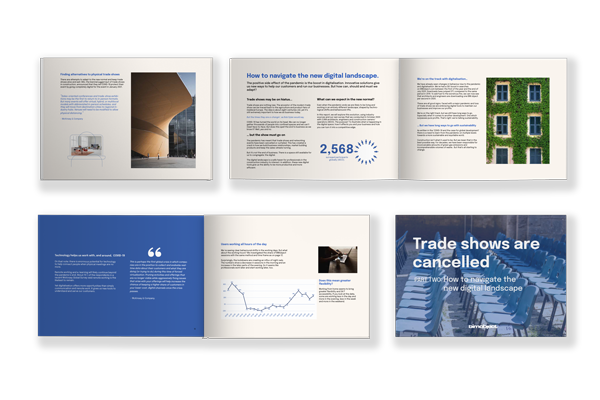
This blog post is a summary of part two of the three-part series, where we dive into how COVID-19 is changing our industry and how we work. The report is based on insights from 2,568 real-life architects, engineers, constructors, and owners/operators (AECO).
Part two focuses on how the pandemic has propelled the need for digital alternatives in a time without face-to-face interactions. Download the full-length report for FREE.
Trade shows are canceled for the foreseeable future.
The year 2020 dealt a blow that left the construction industry –and the world – stung and stunned. The problem is simple but substantial: the COVID-19 virus passes from person to person, so to protect public health, we must limit physical interactions and practice social distancing.
What are the direct implications for our industry?
The trade shows that we’ve relied so heavily on were immediately put on hiatus. As a result, we’ve been forced to mend a sudden (perhaps irrevocable) crack in how we build business relationships, market products, and strike deals.

What’s in the future for the construction industry?
Will the pandemic continue to challenge how our industry operates? And if so, how can you prepare for the eventual outcomes?
Unfortunately, we don’t have a magic crystal ball to predict the construction industry’s post-pandemic position. But what we can do now is give you the coordinates to guide you toward a more future-proof direction.
Trade shows will return. But perhaps not as you know them.
Trade shows were closed down all of 2020. But as the pandemic impacted our willingness to go would we go now, tomorrow, and in the long haul? According to the 2,568 respondents in our survey:
- 7% would be willing to go to an industry event today.
- 43% want to wait until COVID-19 has disappeared or a vaccine has been deployed.
- 50% either won’t go or haven’t decided if they will return to trade shows in the future.

Trade shows will return. The question is just when, how, in which format, and for what purposes. During our part 1 LIVE webinar (recorded version available), Emil Augustusson, Head of VDC at Veidekke Entreprenad, stated:
“Even after COVID, going to trade shows means putting yourself at risk of contracting other diseases. It could put you out of work for weeks. This new sense of health awareness might impact whether we’re allowed to – or even willing to – go to trade shows in the future.”
AECOs are discovering new products online.
Why do architects, engineers, constructors, and owners/operators (AECOs) go to trade shows?
Trade shows are canceled: How to navigate the new digital landscape ranks the top four reasons. Surprisingly, 46% of our 2,568 respondents go for educational purposes. Product research comes in second – 20% behind.
But the times they are a-changin', as Bob Dylan oh-so famously would say.
The technological innovations that once revolutionized the world have now become a part of our societal DNA. Even though the construction industry as a whole is lagging in terms of digitalization; the people within it are starting to progress.
Case in point: almost half of the respondents in our survey state that they use search engines to discover new products. Less than 10% reserve the task for trade shows.

Architects and engineers are embracing digital work.
Digital tools are reinventing human interactions and revolutionizing how we consume information. And it’s safe to say that the pandemic is adding fuel to the fires of change.
Case in point: more than half of the respondents in our AECO survey stated that their work has become a lot more digital since COVID-19 – a trend that’s likely to accelerate in the coming years.
After analyzing user activity on BIMobject.com, we found a substantial increase in searches and downloads. In addition, designers are active in the marketplace in the later parts of the evening and on weekends. Want the exact numbers? Download the FREE report.
These are all good signs. Faced with a major pandemic and loss of trade shows, we’re embracing digital tools to maintain our businesses and improve our profits. But are we meeting their demands? The harrowing answer is: no.
Manufacturers aren’t meeting digital demands.
According to Venveo, the first place architects go to find information is the manufacturer’s website. That’s all fine and dandy, but the same source states that several architects felt frustrated with the lack of information and the difficulty of analyzing product materials or functions.
The moral of the story? Digitalization gives us an opportunity, but we’re not fully taking advantage of it.
Yet.

Are trade shows delivering the right results?
Trade shows are incredibly useful. But in the digital age, when measurability and data are key, we might need to reevaluate their business purpose and value.
In terms of the sales pipeline, trade shows are slow cookers. We’re spending a lot of money on our booths, but the sales may not trickle in until weeks, months, or maybe a year after the event.
How can digital tools help sell building products?
The ongoing digitalization process will force manufacturers to think of better ways to market and sell their products. It might seem daunting, but the rewards far outweigh the initial scare.
Digital tools and channels can pack a serious punch when it comes to productivity and profits. It enables us to act on real-time behavior, create more sales opportunities and predict trends. All while being able to map every buyer’s journey and the return on investment.
We’re on the right track, but we still have long ways to go. Especially when it comes to another development. One which surpasses pure profits.
That’s right: we’re talking sustainability.

Digitalization enables sustainability in construction.
For decades, the construction industry has been responsible for inconceivable amounts of green gas emissions and incomprehensible volumes of waste.
Digitalization tools, such as BIM objects, give us the information we need to forecast and minimize every project’s CO2 footprint. It provides a holistic project overview which allows us to catch possible construction faults before the shovel even hits the ground.
Not only does this enable us to make greener choices, but we’ll also save money. Money which can be used to build more schools, better hospitals, and safer housing. It’s a win for you and a win for the world around you.
The future of construction is in the digital.
Remember when we claimed that we couldn’t predict the future of the construction industry? Well, it’s still true.
However…
The odds are stacked against the traditionalists. The digital transformation is coming, and we'll need to reinvent ourselves sooner rather than later.
The world around us is changing. So the question is: do you want to be at the forefront, or do you want to fall behind your competitors?
Get the report today.


Sarah Chase
Global Content Marketer













